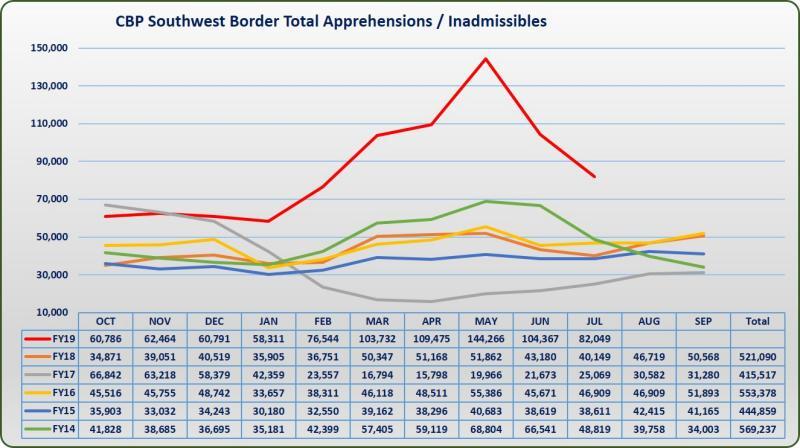The Trump administration’s change, announced Wednesday, to end “catch-and-release” immigration is the 17th initiative announced this year alone — moves that are leading to a decrease in illegal crossings.
“We’re hitting it in the target zone,” acting U.S. Citizenship and Immigrations Services Director Ken Cuccinelli told Secrets from the Texas border.
“Absence of congressional action, the Department of Homeland Security is taking steps,” he added.

In fact, with today’s move to side-step the controversial Flores Settlement Ruling that requires the release of illegals after 20 days, the administration has unveiled 17 reforms to the immigration system that officials credit for the reduction in crossings and apprehensions on the southern border.
“These are so successful in pushing the numbers down,” said Cuccinelli. But, he added, there remains a huge job to cut the numbers further.
Our new policy on public charge will determine whether you are inadmissible to the United States based on your likelihood at any time in the future of receiving public benefits over the designated threshold amount. Get the facts here: https://t.co/e4AMnf4WX9
— USCIS (@USCIS) August 14, 2019
While the timing of recent major initiatives have come while Congress is on recess, he said that the changes have been in the works for a while and have gone through public comment periods.
“It is not a quick snap decision,” said Cuccinelli. “These things have been in the works for a long time.”
They include expanding border wall funding, sending troops to the border, deals with Mexico and Guatemala to hold those seeking asylum in the U.S., and the recent “public charge” rule requiring that migrants not be a financial burden on the U.S.
(5/5) Keeping families together during immigration proceedings, & ensuring that asylum seekers w/ meritorious claims get resolution, are important steps to enhance the integrity of the system & extend protections to those that need them. See more here: https://t.co/fNibhnkxfH
— Acting Sec. Kevin McAleenan (@DHSMcAleenan) August 21, 2019
Incredibly proud of these Border Patrol agents from the Eagle Pass South Station who rescued 28 people, incl. 14 children, from the Rio Grande after they were abandoned by smugglers. This is who the men and women of @CBP are—putting themselves in harm’s way to save others. pic.twitter.com/S9TrQs5OJ3
— Acting Commissioner Mark Morgan (@CBPMarkMorgan) August 20, 2019
“The U.S. is facing a security and humanitarian crisis on the Southern border. The Department of Homeland Security is using all appropriate resources and authorities to address the crisis and execute our missions to secure the borders, enforce immigration and customs laws, facilitate legal trade and travel, counter traffickers, smugglers and transnational criminal organizations, and interdict drugs and illegal contraband,” said DHS.
Below are the immigration efforts unveiled this year by the administration, pulled from a new fact sheet:
- Flores change to stop catch-and-release by holding immigrant families in federal facilities while their case is processed instead of releasing them after 20 days and hoping they return to immigration courts.
- Migrant Protection Protocols (MPP), a deal in which migrants seeking admission to the U.S. from Mexico may be required to wait in Mexico. Since it was signed in May, Southwest border arrests have decreased 43%.
- Border Wall. 52 miles new wall built in heavily trafficked areas along the Southern border with 334 miles of border wall promised to be built by the end of 2020.
- 5,000 troops have been sent to the border.
- The Pentagon has redirected $2.5 billion from the military construction budget to help build 100 miles of the wall along the Southern border.
- The U.S. and Guatemala agreed to enter an Asylum Cooperative Agreement to allow asylum seekers to be transported to Guatemala to seek asylum there first.
- $4.6 billion in emergency aid sought by the administration was approved. The administration said it provided “minimal funding for the humanitarian mission at the border, providing supplies for the hundreds of thousands of aliens coming into the country each month.”
- The “asylum rule” made migrants ineligible for asylum if they passed through another country on their way to the U.S. without claiming asylum there. Only 10 to 15 percent are ever granted asylum.
- The public charge rule requires immigrants to “be self-sufficient and able to support themselves without specified government welfare benefits.”
- Drug enforcement was expanded. In June, U.S. Customs and Border Patrol seized a vessel that contained 33 thousand pounds of cocaine, one of the largest cocaine drug seizures in history.
- The administration moved to challenge activist judicial decisions.
- Law enforcement has been beefed up, especially at ICE where enforcement and removal operations have been expanded.
- More Border Patrol agents have been assigned to the border.
- More asylum officers, 500 more by the end of the year, have been created.
- Sponsors of migrants are now facing enforcement of their legal responsibilities.
- Justice issued a rule “more clearly defining the category of ‘social groups’ as a claim for credible fear in asylum cases.”
- The minimum investment required in the EB-5 Visa Immigrant Investor Program was increased.

